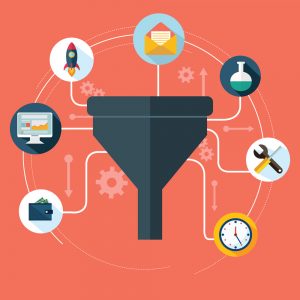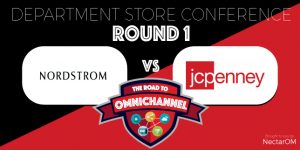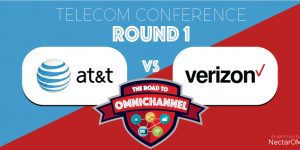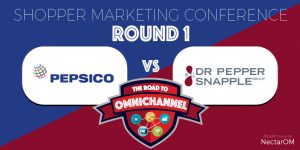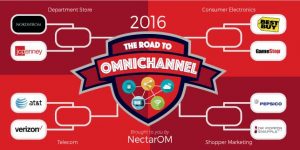Personalization can be a powerful tool in all facets of your business. From growing your e-mail list to increasing sales, giving your audience targeted content can thrust your business to a new level. In fact, by not personalizing you could be sacrificing prospective customers.
Look at it like this. You’ve gone to a site in order to learn how to increase traffic on your blog. You’ve read a couple of articles, but a pop up on the site keeps urging you to sign up for a free guide on e-mail marketing. You don’t even have an e-mail list yet. It seems pointless right?
If the pop up would have targeted you with a guide to using social media for increased traffic, you would have jumped on it, supplying your e-mail and potentially reading more from the site. But instead they lost a potential customer.
The ability to collect behavioral information about your clients is becoming pivotal in creating a successful enterprise. Marketing trends are proving this. Previously, the ability to capture all this data was limited to the Fortune 50 and those who could spend the money. Now, there are attainable options to collect the information yourself, so creating an omni-channel personalization strategy has never been easier.
To further drive the point that personalization is important, look at this article from BCG. It’s expected that by 2020, “roughly 8 percent of the combined GDP of the EU-27” will be from using personalization. That’s a huge percentage when looking at all the other contributors to the GDP.
Personalization and Privacy
Prior to any strategic execution, offer full disclosure to what information you’re collecting and how you’re using it. Also, allow them to control what or how much data you’re able to extract via a preference center. Giving them these choices, along with the ability to opt-out at any time, will keep your business’s integrity and establish greater trust between you and the customer. You’ll be surprised at how many people see the disclosure and quickly accept it. This is a sign of the times we’re in. There is an audience segment that wants nothing to do with their activities being tracked, but the overwhelming majority know giving this information translates to better, more relevant content and services.
When using social media, the platforms do most of this work for you. Sites like Facebook allow the user to determine who sees their profile and who can interact with it. By leaving their personal page open to the public, they’re allowing businesses to collect information from their posts, likes, and interactions. This information can be translated into data for your personalization strategy.
Now that you have that figured out, let’s get to the list of channels you should be considering…
1. Web Content
The old adage that, “It’s only advertising if you don’t want it,” still stands true. Consumers know their data has a value and they’re willing to share it if you provide them value in return. This is where content upgrades, lead magnets like offers, and custom calls to action come into play. They are the currency you’ll use in exchange for better information about your target consumer and customers.
Like in the example above, you need to identify the obvious ‘why’. Learning why a customer is on a particular page of your site is the most basic form of personalization. Without needing to pick up any actual information on the user, you can arrange a pop-up to offer a related product or content upgrade as soon as they read a percentage of the page. The percentage verifies they’re interested in the material, since they’re actually reading it, and it also let’s them get hooked before the pop-up arrives, making it more than a pesky distraction.
On top of this, you can arrange for different versions of your site based off the information collected. For instance, the experience of a user from Denver through a Google search will be offered content for the area and pop ups directed towards the keywords they searched. If the customer is searching for a product, tailor the pop-ups for that item. When a user from Montreal arrives through a Facebook post, they’ll have a different set of content elements, and the specific article they were looking at with content upgrades related to the topic.
A lot of sites do a basic version of this by storing cookies. You’ve seen these, right? Every 7 days, you’ll be asked to join the e-mail list until you do. Some will take it further and use a different style of pop-up for each visitation. Is this right for your brand? That depends on your “brand promise” or the “pillars” your brand has been built upon and the specific use case, but there has to be that exchange.
The important thing to remember is you should always be testing and learning. The way to do that, as you develop your personalization strategy, is by using dynamic content and presenting it as close to real-time as possible using algorithms to identify the effectiveness.
A static page with related content may generally work in the beginning, but that will start to fade. If a viewer reads an article about horses and is offered an ebook on horses, great. If he immediately returns and reads an article about cows and gets an offer for a guide on raising cattle, less great. You could be missing out on an opportunity to sell the Ultimate Guide to Raising Farm Animals. Perhaps the customer arrived through a Google search for the top 10 animals to raise on a farm. Missing that key piece of personalization could cost a sale.
There are a lot of ‘ifs’ in this scenario, but the point is that you need to be constantly using the data that’s available to you in order to maximize the effect.
Creating a website that tracks the behaviors of customers is very manageable now with various approaches. It may take some initial work, but you will know the value of the content you’re serving and you’ll know it by the individual vs. trying to make all content resonate with all visitors. And it’s worth the effort. Optimizing your site to target specific actions and interests of specific individuals can increase your profits as much as 15-25%.
2. Social Media
The benefits of social media outweigh the issues every day of the week. Along with the free platform to engage with your audience, you can also pick up a lot of great information to better your sales. Don’t confuse personalization with socialization, however. Where personalization uses data from an individual to custom tailor an experience, socialization uses a group to apply pressure.
Being recommended to ‘like’ horses, because you like ponies, is personalization. Being recommended to ‘like’ horses, because 11 of your friends do, is socialization.
Facebook is quite likely the strongest social media platform when it comes to personalization. Everything on site collects data. Even if a business can’t collect information from the users, Facebook can.
Ads purchased through Facebook can appear in sidebars along your newsfeed and profile. Featured posts can become embedded into your newsfeed, appearing as though a friend has had a great experience with Tide. Facebook all but monopolizes the market by personalizing the content. Digital marketers know they can efficiently target customers through this system.
When creating ads, you have the ability to target key demographics. Things like location, likes, and interests can be selected to fine tune who sees your ads. Facebook’s ad campaigns also allow you to see your ROI on personalization. They show the amount spent, the number of impressions, and the dollar value of engagements.
Twitter is a different beast. Like Facebook, Twitter collects data from all of their users. The issue is that a tweet is seen for a significantly smaller amount of time than a post. Because of this, understanding your community is essential.
Since the average tweet stays ‘alive’ for only 18 minutes, marketers need to identify when their users are most likely to be online. Study the amount of impressions based off the times of given tweets to know when is best. Take into consideration what time zone a majority of your followers are in. Posting multiple times may be the best course of action.
Ads works generally the same way as Facebook, but stand out more, because of the amount of traffic a feed on Twitter receives. Look over your business’s feed and see what people are sharing the most. You can use the most searched hashtags to forecast marketing trends and coordinate your ads to show up more often.
Social media is your ticket to some easy personalization. Harness its strength to start converting at a faster rate.
3. E-Mail
This is one of the most used and undervalued channels for creating consumer engagement.. By collect data on what products the customer has previously purchased, you can custom target e-mails to meet their needs. eConsultancy reports that 77% of business owners claim that “personalization based on purchase history has a high impact.” A percentage that large illustrates that it’s vital you don’t ignore it.
When a customer makes an entry into the sales funnel, they make the statement, “I am willing to spend money.” That’s the point where you need to identify what other items they’ll be willing to buy. Targeting them with products that don’t pertain to their interest will waste time. After they purchase that horse, send an e-mail offering brushes or feed. You know where their interests sit. Now it’s time to pour gas on the fire.
With modern e-mail automation, it’s easier than ever to have pre-written messages for when a customer buys specific products (i.e., triggers). Strong copywriting can let you capitalize on a customer already willing to spend money.
Creating targeted e-mail lists can benefit your audience, as well. Maintain a massive distribution group for general company information or other stuff you may want to send out, but keep smaller segmented lists for targeted content. One group for horses, one for chickens, but a large for your barnyard news. Your audience will be more likely to open and read emails focused on their interests, giving you more opportunities to make impressions and conversions.
4. Single View of Customer (SVOC)
If 60% of consumers are saying they want personally relevant content and offers, you would think every company would start doing that, right? Well, only a third of corporations report their technology and platforms are providing them an adequate single view of their customer so that 60% is going to be waiting a while.
SVOC is the centerpiece of great omnichannel personalization and it’s a mindset shift for a lot of companies. For years corporate marketing has been built on the concept of mass campaigns and channel programs. The two rarely shared a database and even more rarely combined sales data with them. Today, organizations can truly get to that SVOC with solutions like NectarClickstream and the next step is on the mindshift of marketing to an individual based on their behaviors, as opposed to working against massive segments.
Whatever solution you use, make sure it’s not completely dependent on third party pixels. The ideal tracking platform will incorporate 1st party pixels, redirect links, social data and operational data. This will take some coordination, but when you start seeing that data flow around each individual platform you’ll immediately understand the value and the questions (and corresponding use cases) will start flowing.
Bringing It All Together with Omni-channel Personalization
What good are any of these channels if they’re not slotted into the larger puzzle?
Omni-channel personalization is your strategy that intertwines the various platforms into a single stream of effort. Getting the systems to play nicely together is more of a challenge than setting up any one individually, but it can drastically increase your ROI.
Remember earlier, when we lost the sale for the Ultimate Guide to Raising Farm Animals? If you can get the systems to talk to each other, you wouldn’t miss that sale. The customer would still provide you with his e-mail for the ebook on horses, but you could follow up with a message for the guide. This method converts interested readers into buyers.
Whatever strategy you use to personalize your channels and improve your customer relationship management, make sure you have a backup plan. Constant A/B testing will allow you to stay proactive with what’s working and you can essentially remove any lull in your sales.
Personalization is your ticket to quicker conversions, higher profits and a more satisfied audience. As long as you operate with your customer’s privacy as top of mind, focus on making their interaction with your business a pleasant experience and you stay curious you’ll be successful in your personalization efforts.

